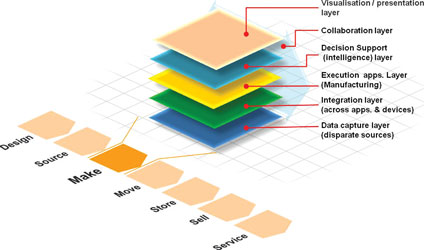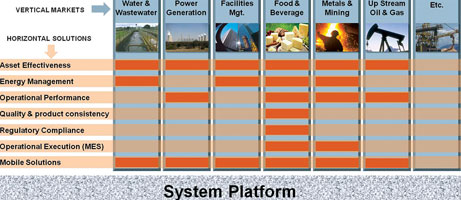

The problems manufacturers are trying to solve today are far more complex than they were 10 years ago and there is every indication that this trend will continue into the future.
Computers were invented to run application software that addresses the unique needs of their owners. Sounds logical when said quickly but as we have discovered in the mining and manufacturing industries over the past few decades, things are not as simple as that. While there is no shortage of application software or authors, what has plagued the industry is the ability of this software to cope with change. Solutions have to evolve at an increasingly rapid rate and suppliers need to re-examine the way they do business in a changing world where things are no longer clear-cut.
Plant equipment changes and so the software that supervises or controls it has to change. Processes change and so must the process control software. Information needs change and so IT is redefined and extended to include the shop floor causing major upheavals in software that must now reconcile two entirely different worlds – and that is all happening because business needs keep changing and will do so increasingly in the future.
Then there is the applications themselves. We all know of the potential horrors of custom development, yet how else is one to address the specific and unique needs of different companies?
How do we best cope with future unknowns while addressing current needs and developing bespoke applications that must be guaranteed to be easily modifiable not only by their authors but also by anyone else?
Ten years ago, there was no answer to these questions, but today things are thankfully quite different.
The need
Before considering how the questions are being answered, it is useful to consider what needs to be done from a macro point of view.
Until fairly recently, it was considered that the ‘Make’ portion of the manufacturing process (Figure 1), could be adequately addressed with process control and maintenance applications – but things have changed and so have manufactures’ perceptions of their primary wealth-creation process, with the result that a supervisory platform is no longer enough.

While the functionality of the data capture layer will remain largely the same, standardisation on specific hardware and software such as PLCs, scadas, etc, may prove counter productive to business efficiency because the benefits of competition are eliminated. Freedom of choice also usually results in a better fit of solution for the task at hand. So, it is fair to say that tomorrow’s factory will have a mixture of disparate data capturing facilities that were bought on purpose rather than as the result of legacy implementations.
The next step then is an integration layer which allows for the building of a model common to all these disparate systems followed by an application execution layer (MES, batch control, etc,) that addresses the functional needs of the enterprise and which provides the information needed by the decision support layer. Finally, there is the visualisation layer where collated information can be displayed in the form required by relevant individuals wherever they may be (control room, office or anywhere on or off the site).
Since all this cannot be done by a single person or department, it is vital to recognise the importance of a collaboration layer which cuts across disciplines and conventional barriers by facilitating the collaboration between people, sites, businesses, solution providers, system integrators and many more.
But how to get there?
The foundation
Taking a page from the book of computer system design, we can see that the computer’s operating system is the foundation for all the software applications that will be written for it. The operating system caters for the gathering of data from a variety of devices (keyboard, disc, I/O, etc), presentation facilities (graphics, text, printed documents, Internet, etc,) and the means by which programmes and programmers can collaborate with one another through knowledge of the operating system rules. In other words, the operating system provides a common reference and an infrastructure for the development of applications. Want to change a printer? Load the new printer driver and you are ready to go – no software changes required.
Would it not be great if this same tried and proven approach could be applied to the computational needs of the mining and manufacturing industries? Well, it can be and it has been.
In this case, however, the foundation or ‘operating system’ consists of a robust infrastructure that provides a common reference for all necessary services and it is referred to as the System Platform (Figure 2) which is based on ArchestrA technology. ArchestrA is a distributed architecture for supervisory control and manufacturing information systems. It is an open and extensible system of components based on a distributed, object-based design that extends the life of legacy systems by leveraging the latest software technologies. Whether automation applications are in discrete manufacturing, process plants, remote scada operations, utilities or any hybrid combination of these types of operations, architecture by ArchestrA has it covered.

The System Platform’s services are divided into the following broad groups:
* The ‘Collaboration’ services include functionality that facilitates trading partner interaction, supply chain connectivity, planning, logistics, warehousing, ERP system connectivity as well as enterprise and other integration facilities (eg, for MES) to name a few.
* The ‘Industrial Application’ services provide the necessary infrastructure for MES, historisation, scada, central configuration management, modelling, security, centralised alarming, device integration, high availability and many more.
* The ‘Presentation’ services include connectivity to mobile devices, industrial panels, desktop HMIs, thin clients and the web.
* The ‘Development’ services provide numerous facilities including an integrated development environment for applications, their maintenance, the definition of plant models and plant items as well as their rapid deployment. These services also ensure that solutions are scalable and re-usable thereby slashing engineering costs when modifying existing systems or developing new projects.
The markets and their applications
Where most solution suppliers saw domain applications as the way to win market share, Wonderware saw things differently and has spent the last 10 or more years developing the foundation on which applications could be built. The result is that Wonderware can now build solid, domain-specific applications that incorporate best practices while all the time protecting the customer’s investment by using existing assets.
The following applications are either already available or will be released shortly:
* Water and Waste Water Industry pack designed to help the industry address its concerns regarding business and regulatory factors, sourcing water supplies as well as, in most cases, an ageing and failing infrastructure.
* Packaging Industry Application as applicable to the CPG as well as the food and beverage industries which face challenges such as the demand for new products, improved customer satisfaction to remain competitive, the management of global supply chains, stringent cost controls, sustained quality and safety compliance.
* Facilities Management Industry Application which assists property owners to comply with ‘green’ regulatory laws, the demand for more space, rising energy costs and the complexity of building automation systems.
* Energy Management Application to help the industry with its quest for new sources of power and energy, conforming to regulatory pressure for clean power generation, handle capacity increases, reduce production and distribution costs as well as dealing with ageing and failing infrastructures.
* Metal and Mining Application geared to assist with reducing energy and production costs, dealing with the scarcity of skilled labour, yield accounting as well as improved health, safety and environmental issues.
* Oil and Gas Application that will assist engineers and management to deal with regulatory pressures, global demand, scarcity of raw material, transportation logistics and costs as well as improved safety and security.
Conclusion
We have come a long way from the bespoke software of 10 years ago that was not only a nightmare to maintain and modify but that was also mostly developed in isolation of other solutions as if the word ‘integration’ had not yet been invented. But it took a decade of sustained effort to realise the answer lay not in the applications themselves but in the infrastructure that would allow them to collaborate in a changing world. Today, the foundation stone of the Wonderware System Platform forms a base which all but eliminates the complexities of system integration and allows engineers to focus on applying and deploying their domain knowledge through sustainable and long-lived applications at a lower cost than before.

For more information contact Deon van Aardt, Wonderware Southern Africa, 0861 WONDER, [email protected], www.wonderware.co.za

© Technews Publishing (Pty) Ltd | All Rights Reserved